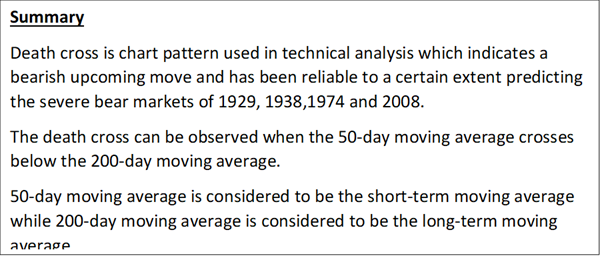What do you mean by Death Cross?
The death cross is a technical chart pattern showing the potential for a significant down move. The death cross shows up on a graph when a stock's short-term moving average crosses below the long-term moving average. Ordinarily, the most well-known moving midpoints utilized in this example are the 50-day and 200-day moving averages.
The pointer gets its name from the supposed strength of the example as a bearish sign. So, merchants who put stock in the example's dependability say that a security is "dead" when this bearish moving average crossover happens.

Source: Copyright © 2021 Kalkine Media
Understanding Death Cross
The death cross marker has been demonstrated to be a solid indicator of the absolute most extreme bear markets of the previous century: in 1929, 1938, 1974, and 2008. Financial backers who escaped the securities exchange toward the beginning of these bear markets kept away from enormous misfortunes that were just about as high as 90% during the 1930s. Since a death cross is a long-term indicator, rather than some transient diagram examples, for example, the Doji, it conveys more weight for financial backers worried about securing gains before another bear market gets in progress. An expansion in volume regularly goes with the presence of the death cross.
The death cross happens when a short-term moving daily (regularly 50-day SMA) gets over a significant long haul moving regular (ordinarily 200-day SMA) to the drawback and is deciphered by investigators and brokers as flagging an authoritative bear turn in a market.
The death cross name gets from the X-shape made when the 50-day moving regular drops underneath the 200-day moving average. The death cross is a sign that transient force in a stock or stock file is easing back. However, it's consistently a reliable marker that a positively trending market is going to end. There have been instances when a death cross showed up, for example, in the mid-year of 2016, when it ends up being a bogus marker. The individuals who escaped stocks throughout the mid-year of 2016 missed the sizable securities exchange acquires that followed all through 2017. The 2016 death cross model was indeed happening during a technical amendment of around 10%, which is seen as a purchase opportunity in many cases.

Source: Copyright © 2021 Kalkine Media
There is some variety of assessment as to correctly what establishes this significant moving average crossover. A few investigators characterize it as a hybrid of the 100-day moving, usually by the 30-day moving average, while others describe it as the hybrid of the 200-day normal by the 50-day normal. Experts additionally watch for the crossover happening on lower period graphs to affirm a solid, continuous pattern. Although varieties in the exact definition or the period applied, the term consistently alludes to a short-term moving average, which was at a higher worth, crossing below a long-term moving average.
There are three essential stages in the arrangement of the formation of the death cross pattern.
- The principal stage includes the current upswing of security when it starts to arrive at its top as purchasing energy eases off. Then, at that point, the value begins to fall as sellers acquire the advantage on the lookout.
- The subsequent stage is the decrease in the security's cost to a point where the genuine death cross happens, with the 50-day moving average falling beneath the 200-day moving average. This disadvantage shift of the 50-day standard signals another, a bearish long-haul pattern on the lookout.
- The last stage happens with the continuation of the descending development on the lookout. The new downtrend should be supported altogether for a certified death cross to be considered to have occurred. If the time of descending energy is fleeting, and the stock turns around to the potential gain, then, at that point, the cross of death is viewed as a bogus sign.
The death cross example is more helpful to showcase experts and merchants when other specialized indicators affirm its sign. Quite possibly, the most famous technical pointer to affirm a drawn-out pattern change is exchanging volume. The bearish cross example is viewed as a more solid sign if it happens alongside high trading volumes. The higher trading volume demonstrates more financial backers getting tied up with the possibility of a significant pattern change. Indicators, for example, the MACD, can likewise be utilized for affirmation. They function admirably because the momentum of the long-term trend slows down just before the market reverses.
While there are doubters to each indicator, numerous financial backers view the death cross as a critical outline design. Examination shows the death cross example happened in essential market indices, precisely estimating many significant bear market slumps. A death cross example in the Dow Jones Industrial Average went before the accident of 1929. A death cross happened in the S&P 500 Index in May of 2008 – four months before the 2008 bubble.
Frequently Asked Questions
- What is the difference between Golden Cross and Death Cross?
The golden cross happens when a short-term moving regular gets over a significant long haul moving average to the potential gain and is deciphered by investigators and brokers as flagging an authoritative vertical turn in a market. Fundamentally, the momentary standard patterns up quicker than the drawn-out normal until they cross.
There are three phases to a golden cross:
- A downtrend that at last finishes as selling is exhausted
- A second stage where the short-term moving average crosses up through the long-term moving average
- The proceeding upswing, ideally prompting more exorbitant costs
Then again, a contrasting downside moving average crossover represents the death cross and is perceived to flag an unequivocal slump in a market. The death cross happens when the short-term moving average crosses below the long-term moving average, fundamentally going the other way of the golden cross.
The death cross went before the financial slumps in 1929, 1938, 1974, and 2008. There have been ordinarily when a death cross showed up, for example, in the mid-year of 2016, when it became a bogus pointer.
A brilliant cross and a demise cross are accurate, contrary energies. A brilliant cross shows a drawn-out positively trending market going ahead, while a demise cross signals a drawn-out bear market. Both allude to the strong affirmation of a drawn-out pattern by the event of a short-term moving average getting over a significant long haul moving average.
 Please wait processing your request...
Please wait processing your request...